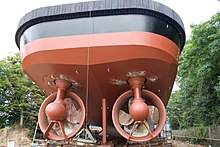Viking Lady
|
||||||||||||||||||
|
||||||||||||||||||
|
||||||||||||||||||
|
||||||||||||||||||
The Viking Lady is a Norwegian utility that was equipped with a fuel cell and accumulators as part of the Fellowship research and development project for experimental purposes in several project steps and is used by Eidesvik Offshore .
General
The ship, which was delivered to Eidesvik Shipping in 2009, has a gas engine based on the diesel-electric principle . The motors work like the fuel cell with LNG LNG (liquefied natural gas) and not emit sulfur dioxide, no carbon black, about 85% less NO x and about 20% less CO 2 . Part of the electrical energy is generated with a fuel cell unit. The Viking Lady is considered by experts to be the first commercial ocean-going vessel to use a fuel cell. It is primarily used to feed the on- board electrical system and thus avoids exposure to noise and exhaust gases , especially in ports .
Development phases
The first phase ran from 2003 to 2005, cost 20 million Norwegian kroner and was used to investigate the technology with the inclusion of the aggregates of marine fuel cells available on the world market. The prerequisite was that the fuel cell could be operated with natural gas .
In the second phase from 2007 to 2012 (93.5 million NOK) the selected components were tested and the interaction was simulated. The fuel cell with 320 kW from MTU Onsite Energy was integrated into the ship's engine system. First in the planning and construction, in 2009 the system was installed and tested in December 2009. In addition, the buffer accumulators have been expanded. The machine system is a hybrid system, consisting of four dual-fuel diesel engines with 2000 kW each and a fuel cell with 320 kW.
In the third phase, starting in 2013, the practical data will be documented with measuring devices and standards and rules for hybrid energy systems will be developed.
Applications of the fuel cell
- Island mode, where the ship (the electrical system) is operated by the fuel cell and battery alone
- Assistance mode in heavy weather, in which the battery is used to reduce frequent load fluctuations on the gas engines
- Dynamic Positioning Mode in which the battery is used with a charge / discharge strategy as power redundancy in order to be able to operate the motors in the efficient range and to reduce frequent load fluctuations.
Web links
Footnotes
- ↑ a b c d e Schiffsdaten , DNV GL , accessed on January 25, 2017.
- ↑ a b c website for the ship: Technology ( Memento from May 5, 2015 in the Internet Archive ), accessed September 11, 2016
- ↑ Viking Lady goes hybrid ( Memento from May 6, 2015 in the Internet Archive ) , website for the ship, November 16, 2011, accessed September 11, 2016.
